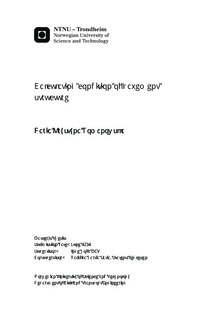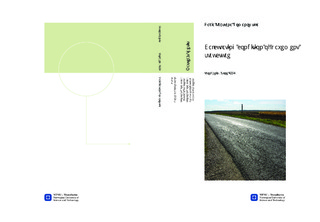| dc.description.abstract | In XX century, Pavement Management System has became obligatory to be used by road agencies. Need of serviceable road system demands the proper maintenance and rehabilitation plans and at that point, Pavement Performance Models step in. They are used to predict the future condition of pavement structure, basing mostly on road, climate and traffic data. The following thesis describes the attempts to implement modern Pavement Performance Models in Norway. With their help, it would be possible to predict pavement s deterioration in better way and therefore, perform better plan maintenance and rehabilitation of the road systems. First chapter of the thesis describes the theory of Pavement Management System. It explains what Pavement Management System is and what are its levels. Later in the chapter, some of the Pavement Performance Models are described. They were considered as potentially relevant for calibration to Norwegian conditions by NordFoU- the Scandinavian co-operation program. The work of NordFoU was also described here. The historical data from Nasjonal Vegdatabank (NVDB) are described in the Chapter 3. Graphs show the rutting in all subsections on two roads- E6 and Fv 704 in Sør- Trøndelag, in Norway. E6 represents the roads with big traffic and Fv704- regional roads with small traffic. The methods of gathering road data by Statens Vegvesen are also described. In Chapter 4, the equations for calculations are shown. All equations have been adopted from the papers published by NordFoU, which are based on the HDM-4 manuals. Some of the equations come from Swedish guidelines about back- calculating E- moduli of the pavement layers. This chapter also contains assumptions and values of the coefficients that were used in calculations within following thesis. Optimisation of calibration factors was done in Excel Solver. These calculations can be found in Appendixes 7, 8, 9 and 10. The results of the calculations are shown in Chapter 5. The measured and calculated results are compared. The model of rutting has shown good correlation with reality. For E6, over 90 % of data were covered with the model. For Fv 704, the correlation was a bit worse, but still satisfactory. Value of coefficient of determination (R2) was calculated to be 58 % using the roughness model. However, in order to get better value, it is possible to further calibrate the model by modifying length of the sections and by using a new measuring equipment (ViaPPS). Chapter 6 includes the conclusion for the performed calibration and HDM-4 models. The correlation between the models and reality has been discussed. The use of studded tyres is observed to be the main contributor to deepening of the mean rut depth, other factors have negligible effect on rutting. In the following thesis calibration of only two HDM-4 models was performed. The two models were rutting and roughness respectively. A good correlation was obtained, however it is recommended to work on roughness and climate models. The rest of the models in a program can be calibrated in the future, after gathering more detailed road data, such as edge- break and cracking. | nb_NO |

